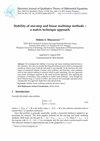求助PDF
{"title":"具有陡势阱的Klein-Gordon-Maxwell方程组非平凡解的存在性和渐近性","authors":"Xueping Wen, Chunfang Chen","doi":"10.14232/ejqtde.2023.1.17","DOIUrl":null,"url":null,"abstract":"<jats:p>In this paper, we consider the following nonlinear Klein–Gordon–Maxwell system with a steep potential well <mml:math xmlns:mml=\"http://www.w3.org/1998/Math/MathML\" xmlns=\"http://www.w3.org/1998/Math/MathML\" display=\"block\"> <mml:mrow> <mml:mo>{</mml:mo> <mml:mtable columnalign=\"left left\" rowspacing=\".2em\" columnspacing=\"1em\" displaystyle=\"false\"> <mml:mtr> <mml:mtd> <mml:mo>−<!-- − --></mml:mo> <mml:mi mathvariant=\"normal\">Δ<!-- Δ --></mml:mi> <mml:mi>u</mml:mi> <mml:mo>+</mml:mo> <mml:mo stretchy=\"false\">(</mml:mo> <mml:mi>λ<!-- λ --></mml:mi> <mml:mi>a</mml:mi> <mml:mo stretchy=\"false\">(</mml:mo> <mml:mi>x</mml:mi> <mml:mo stretchy=\"false\">)</mml:mo> <mml:mo>+</mml:mo> <mml:mn>1</mml:mn> <mml:mo stretchy=\"false\">)</mml:mo> <mml:mi>u</mml:mi> <mml:mo>−<!-- − --></mml:mo> <mml:mi>μ<!-- μ --></mml:mi> <mml:mo stretchy=\"false\">(</mml:mo> <mml:mn>2</mml:mn> <mml:mi>ω<!-- ω --></mml:mi> <mml:mo>+</mml:mo> <mml:mi>ϕ<!-- ϕ --></mml:mi> <mml:mo stretchy=\"false\">)</mml:mo> <mml:mi>ϕ<!-- ϕ --></mml:mi> <mml:mi>u</mml:mi> <mml:mo>=</mml:mo> <mml:mi>f</mml:mi> <mml:mo stretchy=\"false\">(</mml:mo> <mml:mi>x</mml:mi> <mml:mo>,</mml:mo> <mml:mi>u</mml:mi> <mml:mo stretchy=\"false\">)</mml:mo> <mml:mo>,</mml:mo> </mml:mtd> <mml:mtd> <mml:mtext>in</mml:mtext> <mml:mspace width=\"thinmathspace\" /> <mml:msup> <mml:mrow class=\"MJX-TeXAtom-ORD\"> <mml:mi mathvariant=\"double-struck\">R</mml:mi> </mml:mrow> <mml:mn>3</mml:mn> </mml:msup> <mml:mo>,</mml:mo> </mml:mtd> </mml:mtr> <mml:mtr> <mml:mtd> <mml:mi mathvariant=\"normal\">Δ<!-- Δ --></mml:mi> <mml:mi>ϕ<!-- ϕ --></mml:mi> <mml:mo>=</mml:mo> <mml:mi>μ<!-- μ --></mml:mi> <mml:mo stretchy=\"false\">(</mml:mo> <mml:mi>ω<!-- ω --></mml:mi> <mml:mo>+</mml:mo> <mml:mi>ϕ<!-- ϕ --></mml:mi> <mml:mo stretchy=\"false\">)</mml:mo> <mml:msup> <mml:mi>u</mml:mi> <mml:mn>2</mml:mn> </mml:msup> <mml:mo>,</mml:mo> </mml:mtd> <mml:mtd> <mml:mtext>in</mml:mtext> <mml:mspace width=\"thinmathspace\" /> <mml:msup> <mml:mrow class=\"MJX-TeXAtom-ORD\"> <mml:mi mathvariant=\"double-struck\">R</mml:mi> </mml:mrow> <mml:mn>3</mml:mn> </mml:msup> <mml:mo>,</mml:mo> </mml:mtd> </mml:mtr> </mml:mtable> <mml:mo fence=\"true\" stretchy=\"true\" symmetric=\"true\" /> </mml:mrow> </mml:math> where <mml:math xmlns:mml=\"http://www.w3.org/1998/Math/MathML\" xmlns=\"http://www.w3.org/1998/Math/MathML\"> <mml:mi>ω<!-- ω --></mml:mi> <mml:mo>></mml:mo> <mml:mn>0</mml:mn> </mml:math> is a constant, <mml:math xmlns:mml=\"http://www.w3.org/1998/Math/MathML\" xmlns=\"http://www.w3.org/1998/Math/MathML\"> <mml:mi>μ<!-- μ --></mml:mi> </mml:math> and <mml:math xmlns:mml=\"http://www.w3.org/1998/Math/MathML\" xmlns=\"http://www.w3.org/1998/Math/MathML\"> <mml:mi>λ<!-- λ --></mml:mi> </mml:math> are positive parameters, <mml:math xmlns:mml=\"http://www.w3.org/1998/Math/MathML\" xmlns=\"http://www.w3.org/1998/Math/MathML\"> <mml:mi>f</mml:mi> <mml:mo>∈<!-- ∈ --></mml:mo> <mml:mi>C</mml:mi> <mml:mo stretchy=\"false\">(</mml:mo> <mml:msup> <mml:mrow class=\"MJX-TeXAtom-ORD\"> <mml:mi mathvariant=\"double-struck\">R</mml:mi> </mml:mrow> <mml:mn>3</mml:mn> </mml:msup> <mml:mo>×<!-- × --></mml:mo> <mml:mrow class=\"MJX-TeXAtom-ORD\"> <mml:mi mathvariant=\"double-struck\">R</mml:mi> </mml:mrow> <mml:mo>,</mml:mo> <mml:mrow class=\"MJX-TeXAtom-ORD\"> <mml:mi mathvariant=\"double-struck\">R</mml:mi> </mml:mrow> <mml:mo stretchy=\"false\">)</mml:mo> </mml:math> and the nonlinearity <mml:math xmlns:mml=\"http://www.w3.org/1998/Math/MathML\" xmlns=\"http://www.w3.org/1998/Math/MathML\"> <mml:mi>f</mml:mi> </mml:math> satisfies the Ambrosetti–Rabinowitz condition. We use parameter-dependent compactness lemma to prove the existence of nontrivial solution for <mml:math xmlns:mml=\"http://www.w3.org/1998/Math/MathML\" xmlns=\"http://www.w3.org/1998/Math/MathML\"> <mml:mi>μ<!-- μ --></mml:mi> </mml:math> small and <mml:math xmlns:mml=\"http://www.w3.org/1998/Math/MathML\" xmlns=\"http://www.w3.org/1998/Math/MathML\"> <mml:mi>λ<!-- λ --></mml:mi> </mml:math> large enough, then explore the asymptotic behavior as <mml:math xmlns:mml=\"http://www.w3.org/1998/Math/MathML\" xmlns=\"http://www.w3.org/1998/Math/MathML\"> <mml:mi>μ<!-- μ --></mml:mi> <mml:mo stretchy=\"false\">→<!-- → --></mml:mo> <mml:mn>0</mml:mn> </mml:math> and <mml:math xmlns:mml=\"http://www.w3.org/1998/Math/MathML\" xmlns=\"http://www.w3.org/1998/Math/MathML\"> <mml:mi>λ<!-- λ --></mml:mi> <mml:mo stretchy=\"false\">→<!-- → --></mml:mo> <mml:mi mathvariant=\"normal\">∞<!-- ∞ --></mml:mi> </mml:math>. Moreover, we also use truncation technique to study the existence and asymptotic behavior of positive solution of Klein–Gordon–Maxwell system when <mml:math xmlns:mml=\"http://www.w3.org/1998/Math/MathML\" xmlns=\"http://www.w3.org/1998/Math/MathML\"> <mml:mi>f</mml:mi> <mml:mo stretchy=\"false\">(</mml:mo> <mml:mi>u</mml:mi> <mml:mo stretchy=\"false\">)</mml:mo> <mml:mo>:=</mml:mo> <mml:mrow class=\"MJX-TeXAtom-ORD\"> <mml:mo stretchy=\"false\">|</mml:mo> </mml:mrow> <mml:mi>u</mml:mi> <mml:msup> <mml:mrow class=\"MJX-TeXAtom-ORD\"> <mml:mo stretchy=\"false\">|</mml:mo> </mml:mrow> <mml:mrow class=\"MJX-TeXAtom-ORD\"> <mml:mi>q</mml:mi> <mml:mo>−<!-- − --></mml:mo> <mml:mn>2</mml:mn> </mml:mrow> </mml:msup> <mml:mi>u</mml:mi> </mml:math> where <mml:math xmlns:mml=\"http://www.w3.org/1998/Math/MathML\" xmlns=\"http://www.w3.org/1998/Math/MathML\"> <mml:mn>2</mml:mn> <mml:mo><</mml:mo> <mml:mi>q</mml:mi> <mml:mo><</mml:mo> <mml:mn>4</mml:mn> </mml:math>.</jats:p>","PeriodicalId":50537,"journal":{"name":"Electronic Journal of Qualitative Theory of Differential Equations","volume":"326 1","pages":""},"PeriodicalIF":0.8000,"publicationDate":"2023-01-01","publicationTypes":"Journal Article","fieldsOfStudy":null,"isOpenAccess":false,"openAccessPdf":"","citationCount":"0","resultStr":"{\"title\":\"Existence and asymptotic behavior of nontrivial solution for Klein–Gordon–Maxwell system with steep potential well\",\"authors\":\"Xueping Wen, Chunfang Chen\",\"doi\":\"10.14232/ejqtde.2023.1.17\",\"DOIUrl\":null,\"url\":null,\"abstract\":\"<jats:p>In this paper, we consider the following nonlinear Klein–Gordon–Maxwell system with a steep potential well <mml:math xmlns:mml=\\\"http://www.w3.org/1998/Math/MathML\\\" xmlns=\\\"http://www.w3.org/1998/Math/MathML\\\" display=\\\"block\\\"> <mml:mrow> <mml:mo>{</mml:mo> <mml:mtable columnalign=\\\"left left\\\" rowspacing=\\\".2em\\\" columnspacing=\\\"1em\\\" displaystyle=\\\"false\\\"> <mml:mtr> <mml:mtd> <mml:mo>−<!-- − --></mml:mo> <mml:mi mathvariant=\\\"normal\\\">Δ<!-- Δ --></mml:mi> <mml:mi>u</mml:mi> <mml:mo>+</mml:mo> <mml:mo stretchy=\\\"false\\\">(</mml:mo> <mml:mi>λ<!-- λ --></mml:mi> <mml:mi>a</mml:mi> <mml:mo stretchy=\\\"false\\\">(</mml:mo> <mml:mi>x</mml:mi> <mml:mo stretchy=\\\"false\\\">)</mml:mo> <mml:mo>+</mml:mo> <mml:mn>1</mml:mn> <mml:mo stretchy=\\\"false\\\">)</mml:mo> <mml:mi>u</mml:mi> <mml:mo>−<!-- − --></mml:mo> <mml:mi>μ<!-- μ --></mml:mi> <mml:mo stretchy=\\\"false\\\">(</mml:mo> <mml:mn>2</mml:mn> <mml:mi>ω<!-- ω --></mml:mi> <mml:mo>+</mml:mo> <mml:mi>ϕ<!-- ϕ --></mml:mi> <mml:mo stretchy=\\\"false\\\">)</mml:mo> <mml:mi>ϕ<!-- ϕ --></mml:mi> <mml:mi>u</mml:mi> <mml:mo>=</mml:mo> <mml:mi>f</mml:mi> <mml:mo stretchy=\\\"false\\\">(</mml:mo> <mml:mi>x</mml:mi> <mml:mo>,</mml:mo> <mml:mi>u</mml:mi> <mml:mo stretchy=\\\"false\\\">)</mml:mo> <mml:mo>,</mml:mo> </mml:mtd> <mml:mtd> <mml:mtext>in</mml:mtext> <mml:mspace width=\\\"thinmathspace\\\" /> <mml:msup> <mml:mrow class=\\\"MJX-TeXAtom-ORD\\\"> <mml:mi mathvariant=\\\"double-struck\\\">R</mml:mi> </mml:mrow> <mml:mn>3</mml:mn> </mml:msup> <mml:mo>,</mml:mo> </mml:mtd> </mml:mtr> <mml:mtr> <mml:mtd> <mml:mi mathvariant=\\\"normal\\\">Δ<!-- Δ --></mml:mi> <mml:mi>ϕ<!-- ϕ --></mml:mi> <mml:mo>=</mml:mo> <mml:mi>μ<!-- μ --></mml:mi> <mml:mo stretchy=\\\"false\\\">(</mml:mo> <mml:mi>ω<!-- ω --></mml:mi> <mml:mo>+</mml:mo> <mml:mi>ϕ<!-- ϕ --></mml:mi> <mml:mo stretchy=\\\"false\\\">)</mml:mo> <mml:msup> <mml:mi>u</mml:mi> <mml:mn>2</mml:mn> </mml:msup> <mml:mo>,</mml:mo> </mml:mtd> <mml:mtd> <mml:mtext>in</mml:mtext> <mml:mspace width=\\\"thinmathspace\\\" /> <mml:msup> <mml:mrow class=\\\"MJX-TeXAtom-ORD\\\"> <mml:mi mathvariant=\\\"double-struck\\\">R</mml:mi> </mml:mrow> <mml:mn>3</mml:mn> </mml:msup> <mml:mo>,</mml:mo> </mml:mtd> </mml:mtr> </mml:mtable> <mml:mo fence=\\\"true\\\" stretchy=\\\"true\\\" symmetric=\\\"true\\\" /> </mml:mrow> </mml:math> where <mml:math xmlns:mml=\\\"http://www.w3.org/1998/Math/MathML\\\" xmlns=\\\"http://www.w3.org/1998/Math/MathML\\\"> <mml:mi>ω<!-- ω --></mml:mi> <mml:mo>></mml:mo> <mml:mn>0</mml:mn> </mml:math> is a constant, <mml:math xmlns:mml=\\\"http://www.w3.org/1998/Math/MathML\\\" xmlns=\\\"http://www.w3.org/1998/Math/MathML\\\"> <mml:mi>μ<!-- μ --></mml:mi> </mml:math> and <mml:math xmlns:mml=\\\"http://www.w3.org/1998/Math/MathML\\\" xmlns=\\\"http://www.w3.org/1998/Math/MathML\\\"> <mml:mi>λ<!-- λ --></mml:mi> </mml:math> are positive parameters, <mml:math xmlns:mml=\\\"http://www.w3.org/1998/Math/MathML\\\" xmlns=\\\"http://www.w3.org/1998/Math/MathML\\\"> <mml:mi>f</mml:mi> <mml:mo>∈<!-- ∈ --></mml:mo> <mml:mi>C</mml:mi> <mml:mo stretchy=\\\"false\\\">(</mml:mo> <mml:msup> <mml:mrow class=\\\"MJX-TeXAtom-ORD\\\"> <mml:mi mathvariant=\\\"double-struck\\\">R</mml:mi> </mml:mrow> <mml:mn>3</mml:mn> </mml:msup> <mml:mo>×<!-- × --></mml:mo> <mml:mrow class=\\\"MJX-TeXAtom-ORD\\\"> <mml:mi mathvariant=\\\"double-struck\\\">R</mml:mi> </mml:mrow> <mml:mo>,</mml:mo> <mml:mrow class=\\\"MJX-TeXAtom-ORD\\\"> <mml:mi mathvariant=\\\"double-struck\\\">R</mml:mi> </mml:mrow> <mml:mo stretchy=\\\"false\\\">)</mml:mo> </mml:math> and the nonlinearity <mml:math xmlns:mml=\\\"http://www.w3.org/1998/Math/MathML\\\" xmlns=\\\"http://www.w3.org/1998/Math/MathML\\\"> <mml:mi>f</mml:mi> </mml:math> satisfies the Ambrosetti–Rabinowitz condition. We use parameter-dependent compactness lemma to prove the existence of nontrivial solution for <mml:math xmlns:mml=\\\"http://www.w3.org/1998/Math/MathML\\\" xmlns=\\\"http://www.w3.org/1998/Math/MathML\\\"> <mml:mi>μ<!-- μ --></mml:mi> </mml:math> small and <mml:math xmlns:mml=\\\"http://www.w3.org/1998/Math/MathML\\\" xmlns=\\\"http://www.w3.org/1998/Math/MathML\\\"> <mml:mi>λ<!-- λ --></mml:mi> </mml:math> large enough, then explore the asymptotic behavior as <mml:math xmlns:mml=\\\"http://www.w3.org/1998/Math/MathML\\\" xmlns=\\\"http://www.w3.org/1998/Math/MathML\\\"> <mml:mi>μ<!-- μ --></mml:mi> <mml:mo stretchy=\\\"false\\\">→<!-- → --></mml:mo> <mml:mn>0</mml:mn> </mml:math> and <mml:math xmlns:mml=\\\"http://www.w3.org/1998/Math/MathML\\\" xmlns=\\\"http://www.w3.org/1998/Math/MathML\\\"> <mml:mi>λ<!-- λ --></mml:mi> <mml:mo stretchy=\\\"false\\\">→<!-- → --></mml:mo> <mml:mi mathvariant=\\\"normal\\\">∞<!-- ∞ --></mml:mi> </mml:math>. Moreover, we also use truncation technique to study the existence and asymptotic behavior of positive solution of Klein–Gordon–Maxwell system when <mml:math xmlns:mml=\\\"http://www.w3.org/1998/Math/MathML\\\" xmlns=\\\"http://www.w3.org/1998/Math/MathML\\\"> <mml:mi>f</mml:mi> <mml:mo stretchy=\\\"false\\\">(</mml:mo> <mml:mi>u</mml:mi> <mml:mo stretchy=\\\"false\\\">)</mml:mo> <mml:mo>:=</mml:mo> <mml:mrow class=\\\"MJX-TeXAtom-ORD\\\"> <mml:mo stretchy=\\\"false\\\">|</mml:mo> </mml:mrow> <mml:mi>u</mml:mi> <mml:msup> <mml:mrow class=\\\"MJX-TeXAtom-ORD\\\"> <mml:mo stretchy=\\\"false\\\">|</mml:mo> </mml:mrow> <mml:mrow class=\\\"MJX-TeXAtom-ORD\\\"> <mml:mi>q</mml:mi> <mml:mo>−<!-- − --></mml:mo> <mml:mn>2</mml:mn> </mml:mrow> </mml:msup> <mml:mi>u</mml:mi> </mml:math> where <mml:math xmlns:mml=\\\"http://www.w3.org/1998/Math/MathML\\\" xmlns=\\\"http://www.w3.org/1998/Math/MathML\\\"> <mml:mn>2</mml:mn> <mml:mo><</mml:mo> <mml:mi>q</mml:mi> <mml:mo><</mml:mo> <mml:mn>4</mml:mn> </mml:math>.</jats:p>\",\"PeriodicalId\":50537,\"journal\":{\"name\":\"Electronic Journal of Qualitative Theory of Differential Equations\",\"volume\":\"326 1\",\"pages\":\"\"},\"PeriodicalIF\":0.8000,\"publicationDate\":\"2023-01-01\",\"publicationTypes\":\"Journal Article\",\"fieldsOfStudy\":null,\"isOpenAccess\":false,\"openAccessPdf\":\"\",\"citationCount\":\"0\",\"resultStr\":null,\"platform\":\"Semanticscholar\",\"paperid\":null,\"PeriodicalName\":\"Electronic Journal of Qualitative Theory of Differential Equations\",\"FirstCategoryId\":\"100\",\"ListUrlMain\":\"https://doi.org/10.14232/ejqtde.2023.1.17\",\"RegionNum\":4,\"RegionCategory\":\"数学\",\"ArticlePicture\":[],\"TitleCN\":null,\"AbstractTextCN\":null,\"PMCID\":null,\"EPubDate\":\"\",\"PubModel\":\"\",\"JCR\":\"Q1\",\"JCRName\":\"MATHEMATICS\",\"Score\":null,\"Total\":0}","platform":"Semanticscholar","paperid":null,"PeriodicalName":"Electronic Journal of Qualitative Theory of Differential Equations","FirstCategoryId":"100","ListUrlMain":"https://doi.org/10.14232/ejqtde.2023.1.17","RegionNum":4,"RegionCategory":"数学","ArticlePicture":[],"TitleCN":null,"AbstractTextCN":null,"PMCID":null,"EPubDate":"","PubModel":"","JCR":"Q1","JCRName":"MATHEMATICS","Score":null,"Total":0}
引用次数: 0
引用
批量引用
Existence and asymptotic behavior of nontrivial solution for Klein–Gordon–Maxwell system with steep potential well
In this paper, we consider the following nonlinear Klein–Gordon–Maxwell system with a steep potential well { − Δ u + ( λ a ( x ) + 1 ) u − μ ( 2 ω + ϕ ) ϕ u = f ( x , u ) , in R 3 , Δ ϕ = μ ( ω + ϕ ) u 2 , in R 3 , where ω > 0 is a constant, μ and λ are positive parameters, f ∈ C ( R 3 × R , R ) and the nonlinearity f satisfies the Ambrosetti–Rabinowitz condition. We use parameter-dependent compactness lemma to prove the existence of nontrivial solution for μ small and λ large enough, then explore the asymptotic behavior as μ → 0 and λ → ∞ . Moreover, we also use truncation technique to study the existence and asymptotic behavior of positive solution of Klein–Gordon–Maxwell system when f ( u ) := | u | q − 2 u where 2 < q < 4 .

 求助内容:
求助内容: 应助结果提醒方式:
应助结果提醒方式:


